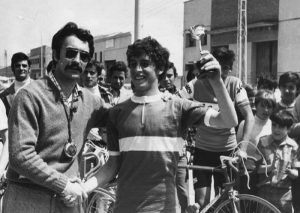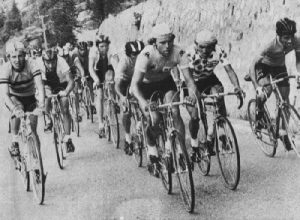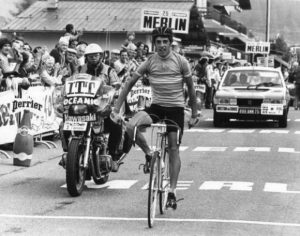BIOGRAPHY – beginnings
The family album
Pedro Delgado was born on 15th April 1960 in the town of Segovia (Spain). He was the third child of Victorina and Julio, his parents. His sisters and brother are called Marisa, Victoria and Julio. In his early years Perico had many health problems, he was a sickly child and, according to his family, he was«not much to look at physically». «I remember my Mother used to come to my bedside to bring me fruit juice and when I drank it, she would say loving words to me to help me get better soon». When he was 12 and after having spent three months in bed with hepatitis, suddenly his health improved and a new stage in his life began.
«I always liked playing sport a lot and played both at school and in the neighbourhood where most of our free time was spent on sport activities. We would play anything, basketball, football, tennis against a wall, go running….»;.
He went to the Santa Eulalia and Calvo Sotelo primary schools and later to the Andrés Laguna Grammar School, all of which were in Segovia. He was an average student. He would usually pass everything, although curiously he especially disliked French. At the beginning he combined his studies with his cycling training.
My first pedal-strokes
There is no history of cycling or sport in Pedro’s family. His first memory of a bicycle was from his neighbourhood. When he was 9 or 10, a neighbour and friend called José used to lend his bike to everyone. «In those days, hardly any kids from Pío XII (his neighbourhood) had bikes. Very gradually the parents began to buy bicycles for their children and in the summers the children would go on their bicycles to bathe in the river or on bicycle trips to the outskirts of Segovia». «As I didn’t have a bike, I used to stay alone at home». .
«I got my first bicycle when I helped my brother Julio (much more determined than me) on his paper round for the local paper (El Adelantado de Segovia). After saving for three months, I convinced him to buy our first bicycle. It was an Orbea (the brand that in later years formed a professional cycling team in which I rode in 1985 and won the Tour of Spain) that was blue and was actually a girls’ bicycle as they were called then because it didn’t have a top tube . It cost us 3,000 pts». «But I wanted a racing bike and after saving for a few more months, I was able to buy my first racing bike which cost me 5,000 pts. It was made of iron but it was marvellous».
The cycling world beckons
Pedro had a friend at school called Frutos Arenal who competed in cycling races and sometimes. Pedro would visit his house to see the trophies and medals which he had won, as well as his racing bike. «It was a fabulous bike and weighed nothing next to mine». Pedro sometimes joined Frutos when he went training and his friend persuaded him to apply for a licence in order to take part in races. So in the Autumn of 1974 Pedro took part in his first cycling race dressed in athletics shorts, a t-shirt and trainers and riding his iron bike. It was the Provincial Championship of Segovia.«As there weren’t very many taking part, all the categories rode together. I don’t know whether I was third or fourth of my category as we were all mixed up». From then on he joined the Segovia Cycling Club and never looked back. The following year he became a cadet rider and began to participate regularly in races.
The cadet rider
This was in 1975 and Pedro was beginning his long journey of cycling. In this year he took part in twelve races and won on two occasions. The first victory did not lack one peculiar anecdote. «Some weekends, competitions were held in the Segovia industrial estate and we went round it more or fewer times according to the categories – Infants (12 & 13 years old) or Cadets (14& 15 years old). In turn each group used a gear limited to their category (as still happens today) and you couldn’t use a bigger gear than the established one. During the race I managed to break away. With only one and a half laps to go, my bike broke – (the sprocket got stuck in the back wheel). I was so frustrated, just as I was about to win my first race I couldn’t believe this was happening to me. The spectators were parents and riders of other categories.
As it happened, there was a rider from Infants with his bicycle just where my bike broke down. I went up to him and begged him to lend me his bike. He said «yes, take it, take it» (everybody knows everybody in Segovia). So I took his bike. I was so nervous (my opponents were catching up) that I broke the pedal strap when I pressed it. I pedalled like mad, thinking they would catch me up and that I’d lose the race. My gears were lower than my opponents as I had changed bikes and this one was an Infants’ one. When I crossed the finish line with my arms up I couldn’t believe I had won».
In the Autumn and once again in the Provincial Championships of Segovia, one of the so called «good» juvenile teams came to take part. In actual fact they had really come to see for themselves, the rider who supposedly raced so well and who they had heard about from different sources. It was the Moliner team from Valladolid. Pedro wasn’t actually able to beat them, but he rode so well that after the race, the directeur sportif, Ramón Chamorro Moliner, came to speak to Pedro and offered him to sign up with the Moliner team for the following season.
His father, Julio, agreed so long as Pedro did well in his studies.
The Junior Rider (1976-1978)
«The Moliner team was a serious team, well formed and had good riders for its category. It brought me into immediate contact with the cream of national cycling». He began to ride all over Spain and became well known in cycling circles and especially feared when it came to riding uphill. The team scored victories in at least thirty races in this category.
In the middle of the season of 1978, Pedro decided to become an amateur, as his level was now above the junior category and he wanted new rivals.
«When you go up a category, winning a race becomes much more difficult and nobody gives anything away». He had become impatient, tired of the same rivals, some of whom were habitual wheelsuckers.
 |
| 1976, his first team, Moliner, where he started to mature as a cyclist. |
Aficionado (1978-1981)
Debutó en esta categoría por todo lo alto, en la segunda carrera en que participa, la Vuelta a Lérida, está a punto de ganarla (termina segundo) más tarde consiguió varias victorias ese mismo año.
Con esa proyección sigue formando parte integrante de la selección española de ciclismo participando en el Tour del Porvenir en septiembre de 1979, donde logra la victoria en la etapa reina, frente a la potente y dominadora selección rusa por aquellos años. Se confirma como uno de los mejores escaladores del mundo del ciclismo.
Al final de ese mismo año, con 19 años, tiene tres ofertas para dar el salto al campo profesional, pero el servicio militar obligatorio en España y los estudios, le hace ser cauto y posponer las ofertas al profesionalismo. El ciclismo de competición siempre se lo había tomado como un hobby, no como un fin en sí y aunque todo el mundo le hablaba de lo bueno que era, que tenía madera de campeón, él, se lo tomaba con calma. Se lo pasaba superbien yendo y viniendo por España y Francia, cosechando triunfo tras triunfo, haciendo nuevos amigos y el hablarle de correr con profesionales, le atraía, pero no perdía la cabeza por ello. Al igual que sus padres no creía que fuese a vivir del ciclismo, todo esto era una aventura.
Hubo momentos duros en este período, como anécdota puntual recuerda un Giro de Aficionados en que «se rodaba a mil, con viento de costado y tenía que realizar grandes esfuerzos para no perder la rueda del pelotón. Iba chupando cuneta como un poseso, subíamos repechos y más repechos y mis piernas no daban mucho más de sí. Estás en ese momento en que entregas la cuchara o aguantas un poco mas. Veo que a mi lado se encuentra mi compañero de selección, Angel Camarillo (los dos por aquella época estudiábamos, él Económicas y yo COU), nos miramos uno al otro y en un pequeño parón de la carrera, coincidimos los dos en nuestro estado de ánimo ‘no puedo con mi alma, esto del ciclismo no esta hecho para mí. Cuando llegue a casa, a estudiar como loco y dejar el ciclismo para otros’. Unas veces llueve, otras hace frío o estas enfermo, pasas días con la moral por los suelos, cansado de pasar penalidades, con ganas de decir, ¡basta ya!, pero cuando llegas al hotel, te duchas, te pones ropa limpia y recibes el masaje diario… cambias, no sólo tu aspecto exterior, sino también el interior y parece que no lo has pasado tan mal… sigues un día más».
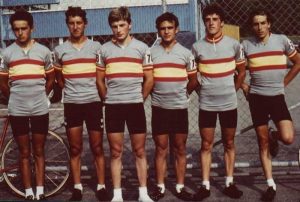 |
| Con la selección española, en la Guillermo Tell, en Suiza, 1980 |
Le toca ir a Tenerife a cumplir el servicio militar, donde a pesar de no tener mucho tiempo para entrenar, consigue tantas victorias como pruebas en que participa con el equipo Jhon Haig. En junio regresa a la península y con el equipo Reynolds de aficionados consigue nuevas victorias. Vuelve a recuperar un poco de su forma física del año pasado con la selección española de ciclismo, pero los chuscos se le atraviesan de vez en cuando y le cuesta mantener su nivel competitivo.Y llega la hora de la verdad, todo ciclista sueña con ser profesional, con rodar con los mejores y tal vez, participar en la Vuelta a España o en el Tour de Francia. Entre dos ofertas, decide continuar con Reynolds, ya como profesionales.
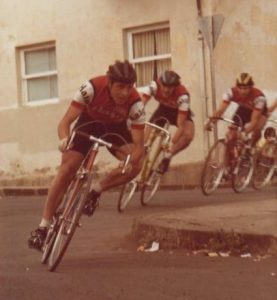 |
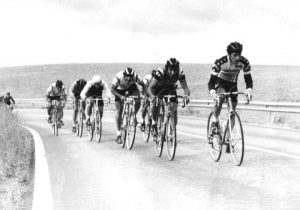 |
| De las 12 pruebas que participa durante la «mili» en Tenerife, consigue la victoria en todas ellas. | Gracias a un permiso durante el servicio militar, Perico ficha por el equipo Reynolds de amateur. |

